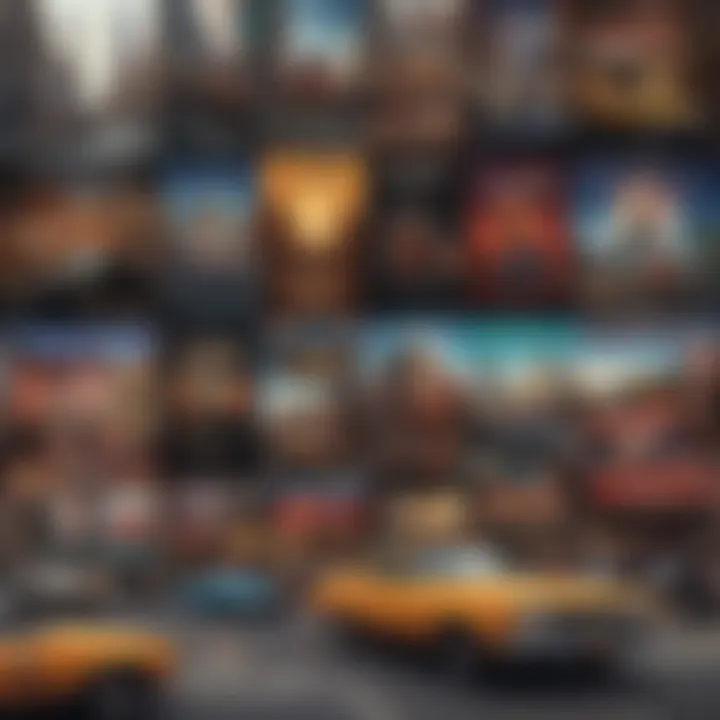Cultural Exchange Through Music in New York City


Intro
New York City stands as a monumental hub where music and culture intersect. The city's diverse musical landscape attracts myriad artists and audiences, creating a unique cultural exchange. This article will guide you through the vibrant musical scene in New York, highlighting its significance, iconic venues, and distinct genres. By examining the experiences of artists in this dynamic environment, we will uncover how the city molds artistic expression and collaboration.
Artist Profile
Biography and Background
New York serves as a backdrop for various musicians, each with their own rich narratives. An artist like Alicia Keys, born and raised in Manhattan, embodies this. With classical training coupled with a passion for R&B and soul, Keys became a symbol of New York's musical identity. Her early life was steeped in the city's culture, which influenced her style and themes in her songs.
Major Influences and Inspirations
Influences in New York's music scene are vast and varied. Genres like hip-hop, jazz, and rock have roots in this melting pot of cultures. For example, artists like Jay-Z draw inspiration from the streets of Brooklyn, blending personal experiences with broader cultural narratives. Similarly, the jazz legends such as Miles Davis shaped the fabric of the music community, constantly pushing creative boundaries. Their journeys offer insight into how New York's environment fosters innovation and collaboration among musicians.
Song Analysis
Theme and Lyrics Breakdown
Examining the lyrics of songs by New York artists reveals the depth of cultural narratives. Take, for instance, "Empire State of Mind" by Jay-Z featuring Alicia Keys. The lyrics articulate ambition, struggle, and culture. They reflect the highs and lows experienced by those living in New York, making the song a powerful anthem for the city.
"Concrete jungle where dreams are made of, there's nothing you can't do."
These lines capture the essence of New York's allure and challenges, resonating with audiences far and wide. It's a reminder that the city's environment influences both music and identity.
Instrumentation and Composition
The instrumentation in New York music also reflects its cultural diversity. Hip-hop often incorporates samples from jazz and soul, while rock bands may blend punk and pop elements. For example, The Strokes fuse garage rock with catchy melodies, influenced heavily by the city’s unique soundscape. This melodic mosaic highlights how different styles coexist, leading to new genres and artistic expressions.
Epilogue
Through exploring artists and their songs, it becomes clear that New York City is a vibrant stage for musical and cultural exchange. Its rich history and diverse community foster an environment ripe for innovation and artistic dialogue. As we continue to delve deeper into the lives of artists and their works, it will become evident how essential this city is to their success and cultural identity.
Prologue
In the dynamic landscape of music, New York City stands as a pivotal meeting point for numerous cultures and artistic expressions. This article aims to explore the multiple layers of New York's music scene and its profound impact on cultural exchange. Understanding this relationship is essential for music enthusiasts, aspiring musicians, and students who are looking to dive deeper into the intricacies of how music can reflect and shape cultural narratives.
The significance of New York's musical heartbeat cannot be understated. Its diverse array of genres provides a canvas for collaboration and innovation. Musicians from various backgrounds gather in this city to exchange ideas, styles, and influences. This cultural exchange is not just about music but extends to community, identity, and artistic expression. The article will delve into important themes like the city’s historical context, the diverse genres that thrive here, and the iconic venues that serve as stages for these extraordinary exchanges.
Through this exploration, a greater understanding of how music serves as a vehicle for cultural dialogue will emerge. The benefits of such understanding include enhanced appreciation of both the historical significance and contemporary relevance of music within New York.
"Music is a universal language that transcends geographical, cultural, and social boundaries. In New York, this language finds its most eloquent expression."
In essence, this section provides a framework for the discussions that follow, emphasizing how music is woven into the very fabric of New York’s cultural identity. It sets the tone for an in-depth examination of not just the sounds emanating from the city but the rich stories and connections they represent.
Understanding New York's Cultural Fabric
To fully grasp the significance of New York's music scene, one must first understand its cultural fabric. New York City is a melting pot where various cultural influences converge. Its history of immigration has created a rich tapestry of communities, each bringing distinct musical traditions. This multifaceted blend breeds creativity and collaboration, making the city a haven for artists seeking inspiration and connection.
Consider the following points about New York's cultural landscape:
- Rich History: Following waves of immigration, New York has been shaped by countless cultures. Each has left an indelible mark on the city’s musical evolution.
- Cultural Exchange: New York allows musicians from different backgrounds to meet, collaborate, and innovate. This exchange often leads to entirely new genres and styles.
- Communities and Support: The city’s neighborhoods foster community engagement through music. Local scenes often emerge from cultural enclaves, creating unique sounds and experiences.
Through these elements, we see how New York serves not just as a backdrop for music, but also as an active participant in cultural dialogue. The music emerging from this city does not merely entertain; it narrates the histories, struggles, and triumphs of the people who create it.
The Musical Pulse of New York
New York City is often regarded as the heart of music in America. The relationship between music and the city reflects its soul. Here, different cultures vie for expression through sound. This section will articulate why understanding this musical pulse is crucial for grasping the broader cultural exchange.
Music in New York is not just entertainment; it is activity that unifies people from various backgrounds. It serves as a platform where stories come together. Artists share their narratives, and listeners engage with a collage of experiences. This interaction fosters a unique cultural exchange. Moreover, the importance of music expands beyond enjoyment. In a city filled with diversity, music builds bridges of understanding and experience.
Historical Context of Music in the City
Music in New York has deep roots. From the early days of jazz in Harlem to the rise of punk in the Bowery, the timeline is rich with evolution. Jazz clubs, like the Cotton Club, showcased black talent to predominantly white audiences during the 1920s. This historical context highlights the struggle and triumph of artists within a complex social landscape. It also reflects how music can challenge societal barriers.
Organizations like the New York Philharmonic helped establish the city's reputation as a cultural hub. They introduced classical music to a broader audience while influencing many local musicians. Their concerts contributed to the city's identity, impacting generations.
Overall, understanding this historical context provides clarity on the present state of New York's music scene. It shows how deeply intertwined history and culture are in forming today's musical expressions.


Diversity of Genres
The diversity of music genres found in New York is both astonishing and vital. Genres such as hip-hop, salsa, and classical create a mosaic that represents the city’s multifaceted identity. Each genre is a touchstone of its community, reflecting their experiences and histories.
- Hip-hop, originating from the Bronx in the 1970s, illustrates the spirit of rebellion and creativity. It evolved as a voice for marginalized groups, shaping not just music but also influence on fashion and language.
- Salsa, steeped in Latin traditions, further enriches the scene, creating spaces for communal gatherings and celebrations. Its rhythms and dances reflect the vibrancy of Latin cultures.
- Classical music offers a contrast, often perceived as elitist. However, it continues to inspire musicians across genres, pushing boundaries of musical expression.
This mix of genres contributes significantly to what many label as the "New York Sound." Each genre provides a narrative that speaks to the city's essence. This diversity enhances collaboration among artists, resulting in innovative musical creations.
Iconic Music Venues
Iconic music venues are critical to the cultural landscape of New York City. These places are not just buildings; they are historical sites where music has shaped the city's identity. Venues like Carnegie Hall, Madison Square Garden, and The Apollo Theater have hosted some of the most significant performances in music history. They embody the essence of New York's rich musical tapestry and influence both local and international artists.
The impact of these venues extends beyond their walls. They serve as catalysts for cultural exchange, drawing in diverse audiences. Fans from different backgrounds come together, united by their love for music. This blending of cultures encourages dialog and shared experiences.
Moreover, iconic venues provide essential platforms for artists. Many musicians aspire to perform in these places, associating their success with such prestigious stages. Performing here can propel emerging artists into the spotlight, allowing them to reach wider audiences. It can also solidify established artists' legacies. This mutual relationship is vital for nurturing talent and maintaining the vibrancy of the music scene.
The Role of Concert Halls
Concert halls like Carnegie Hall play a specific role in New York’s music culture. They offer acoustically designed environments that enhance the musical experience. Such spaces host classical performances, popular music concerts, and everything in between. They stand as symbols of artistic excellence, attracting talent from across the globe.
The audience experience at concert halls is also noteworthy. Patrons expect a certain standard, not only in performance quality but also in service and ambiance. From comfortable seating to excellent sightlines, the design of these venues contributes significantly to the audience's overall enjoyment. This focus on quality fosters a culture of appreciation for music that extends beyond mere entertainment.
Underground Clubs and Their Influence
In contrast to the grandeur of concert halls, underground clubs are essential to the New York music scene. Venues like The Bowery Ballroom and Village Vanguard offer intimate settings where artists can experiment and connect with fans on a personal level. These spaces are often described as the heart of the music movement, providing launching pads for new genres and styles.
Underground clubs also reflect the city's ever-changing musical landscape. They embrace emerging trends before they hit mainstream popularity. Genres such as punk, hip hop, and electronic dance music found their beginnings in these venues. The raw energy and creative freedom allow artists to push boundaries and explore new sonic territories.
"Many great musicians began their careers in New York’s underground clubs. These venues are critical for music innovation and cross-genre experimentation."
Additionally, these clubs foster community among artists and fans. Regular performances create a sense of belonging and loyalty. Fans often develop personal relationships with the artists they see frequently, further enhancing the connection between music and cultural identity.
In summary, both concert halls and underground clubs play pivotal roles in New York's music scene. They each contribute to the dynamic exchange of cultural expression through music, ensuring the city remains a fertile ground for new and innovative sounds.
Meet and Collaborate: Artists in New York
New York City’s music scene is characterized by intense collaboration. It stands as a vibrant hub where artists meet, merge ideas, and create anew. This dynamic fosters a rich cultural exchange, enabling musicians to engage with diverse sounds and styles.
Artists gain several benefits from collaborating in this environment. They can learn from one another, pushing their creative boundaries and effectively expanding their repertoire. Collaborations also contribute positively to their networks, allowing them to connect with industry professionals, audiences, and fellow musicians. Additionally, this atmosphere encourages innovation, leading to fresh music that reflects the city's heartbeat.
great collaborations often occur across different genres. This crossing of genres not only broadens the artists' individual horizons but also generates new musical forms. The city’s cultural mosaic provides fertile ground for these interactions.
Cross-Genre Collaborations
Cross-genre collaborations in New York have brought forth groundbreaking musical projects. When artists from different backgrounds join forces, they create something unique and appealing to a wide audience.
Genres such as hip-hop, jazz, rock, and electronic music often mingle in this creative space. For example, notable collaborations between jazz musicians and hip-hop artists have produced compelling work. Producers often seek input from musicians with diverse influences, resulting in a richly layered sound. These intersections serve as showcases for creativity, often leading to innovative live performances that captivate audiences.
Some benefits of such collaborations include:
- Expanding Musical Horizons: Artists reach beyond their genres, discovering new techniques and approaches.
- Diverse Perspectives: Different cultural backgrounds add richness to the creative process.
- Audience Growth: Collaborating artists attract fans from each other's followings, facilitating wider exposure.
Collaborative efforts can redefine an artist's career. They push artists to rethink their artistic identities.
Emerging Artists in the City
The emergence of new talent in New York's music scene is a crucial aspect of its vibrancy. Young musicians come to the city with a fervent desire to make their mark. They contribute to the cultural fabric of the city and often carry influences from their own local scenes, enhancing the diversity of sounds present.
Platforms such as open-mic nights and underground music festivals provide spaces for these emerging artists to display their work. Here, they engage with established musicians, gaining insights and advice that can prove invaluable for their development.
Support structures also play a significant role in fostering their growth. Mentorship programs connect aspiring musicians with seasoned artists. These relationships can lead to fruitful collaborations, sharing of resources, and networking opportunities.
Some notable traits of the new artists in New York include:
- Innovative Sound: New musicians often experiment with their musical styles, contributing to the evolving soundscapes of the city.
- Community Engagement: They tend to actively participate in local events, forging strong ties within their neighborhoods.
- Social Media Use: Emerging artists skillfully utilize platforms to promote their work, creating a strong online presence that complements live performances.
In summary, the collaborative spirit of New York resonates deeply within the artistic community. It propels artists towards new possibilities while shaping the city’s musical identity.
Music Festivals and Events


Music festivals and events play a crucial role in the cultural tapestry of New York City. They offer a unique platform for collaboration, expression, and the celebration of diverse musical traditions. These gatherings attract artists and audiences from different backgrounds, promoting cultural exchange and fostering an appreciation for various genres. Festivals not only enhance the visibility of artists but also support local economies and create community engagement.
In New York, the vibrancy of the music scene is often highlighted during these annual festivals, where both emerging and established artists come together to share their work. This interaction creates an environment ripe for new ideas and innovations in music. Observing how different cultures influence sound can transform how individuals perceive music as a universal language.
Annual Events That Define the Scene
Several key annual events shape the identity of New York’s music culture. Each festival showcases its unique approach, reflecting the city’s eclectic mix.
- SummerStage: Held in Central Park, this festival features a wide range of genres from hip-hop to classical. Artists from different backgrounds take the stage, promoting diversity and inclusivity.
- New York Jazz Festival: Focusing on jazz, this festival honors the historical legacy of the genre in the city while also giving a platform to contemporary artists.
- The Governors Ball: This three-day festival brings together popular musicians from various genres. It emphasizes the connection between different styles and creates a festive atmosphere conducive to cultural exchange.
These events are not just concerts but communal experiences. They bring together fans and artists, creating connections that can lead to future collaborations.
Spotlighting Local Talent
Festivals also play a significant role in spotlighting local talent, providing them with opportunities that can greatly enhance their careers. Emerging artists often perform at these events, gaining exposure to wider audiences. This visibility can lead to record deals, collaborations, and a dedicated fan base.
For many local musicians, performing at these festivals represents a turning point. They can showcase their unique sounds and stories, directly connecting to listeners who share their passion for music.
In addition, some festivals include mentorship programs or workshops featuring established artists. This access to guidance is invaluable for aspiring musicians looking to navigate the complexities of the music industry.
"Music has the power to unite different cultures. Festivals in New York exemplify this through shared experiences and artistic expressions."
By spotlighting local talent, these festivals not only elevate individual artists but also contribute to the richness of New York's music landscape, making it a focal point for cultural exchange.
The Impact of Technology on Music Consumption
In the evolving landscape of music, technology plays a critical role in shaping how artists create, share, and distribute their music. This section will examine the significance of technology in music consumption, focusing on its overarching influence on accessibility, engagement, and the economy of the music industry. The democratization of music through various technological platforms has created a more interconnected environment for both artists and their audiences.
Streaming Platforms and Their Influence
Streaming platforms have revolutionized how music is consumed. Services like Spotify, Apple Music, and Tidal not only offer vast libraries but also tools for personalization and discovery. Users can explore genres and artists from different cultures all within a few clicks. The ease of access to a diverse range of music is unparalleled, allowing listeners to hear both mainstream and indie artists without significant barriers.
Some key benefits of streaming include:
- Affordability: Many platforms offer subscription models, enabling users to access extensive libraries for a low cost.
- Convenience: Users can listen to music anytime and anywhere, with playlists tailored to their tastes.
- Data-Driven Recommendations: Algorithms suggest music based on listening habits, introducing users to new sounds.
Despite these advantages, streaming faces criticism regarding how it compensates artists, often sparking debate on fair wages. The revenue model favors larger labels, raising concerns about the sustainability of careers for emerging musicians. Additionally, some argue that the overwhelming amount of content can lead to saturation, making it harder for individual artists to stand out.
Social Media as a Promotional Tool
In tandem with streaming, social media has emerged as a powerful promotional tool for musicians. Platforms like Instagram, Facebook, and Twitter enable artists to connect directly with fans, cultivating a more engaged audience. These channels provide a space for artists to share updates, behind-the-scenes content, and personal stories, which foster a sense of community around their work.
The impact of social media in the music industry includes:
- Direct Engagement: Artists can interact with fans, build relationships, and receive immediate feedback.
- Cost-Effective Marketing: Musicians can promote their music without the high costs associated with traditional media outlets.
- Viral Potential: A single clip or post can go viral, significantly increasing an artist's visibility without heavy investment.
However, this approach has also led to challenges. The pressure to maintain a constant online presence can be overwhelming. Many artists struggle to balance their creative process with the demands of social media. Additionally, the fast-paced nature of social media can lead to fleeting attention spans, making it challenging for artists to maintain long-term engagement.
"Technology has redefined the music landscape, offering unprecedented access and connection, yet it carries both opportunities and challenges for artists."
In summary, technology has fundamentally altered music consumption through streaming platforms and social media. While these changes provide benefits in accessibility and engagement, they also introduce complexities in the music industry's economic model and the pressure on artists to curate their image and presence online.
Cultural Identity and Music
Cultural identity shapes the way individuals perceive music and express themselves within their communities. In New York City, this aspect resonates profoundly due to the city's vast diversity. From hip-hop in the Bronx to jazz in Harlem, each genre serves as a vessel for unique cultural narratives. This article emphasizes the essential role of music in articulating the experiences of various communities, highlighting how it provides a voice and platform for underrepresented groups.
In this urban melting pot, music functions as more than mere entertainment. It is a reflection of social dynamics, connecting people through shared experiences and backgrounds. For many, engaging with music fosters a sense of belonging and identity. New York City, as a cultural hub, allows for these exchanges to flourish and creates fertile ground for collaboration.
Understanding cultural identity in music can lead to the following benefits:
- Enhanced communication: Music conveys emotions and stories, overcoming language barriers.
- Cultural preservation: Genres allow for the continuation of traditions and histories.
- Social cohesion: Shared musical experiences create a sense of community.
Music As a Reflection of Urban Experience
Music in New York City encapsulates the urban experience vividly. Each beat and lyric tells a story, reflecting daily lives, struggles, and triumphs. The gritty streets of the Bronx gave birth to hip-hop, which emerged from a need for self-expression amid challenges. Rap artists often articulate themes of resilience, showcasing how personal and communal experiences shape their artistic output.
Moreover, genres such as salsa and jazz manifest the rhythms of immigrant life, blending styles and cultures. This creates a rich auditory tapestry that speaks to the complexity of urban identity. The city's neighborhoods each bring forward distinct sounds influenced by their inhabitants' cultural roots.
The Intersection of Race, Class, and Music


Race and class significantly influence the music produced and consumed in New York City. Historically marginalized communities often use music as a form of resistance and empowerment. Genres such as gospel and blues emanate from African American experiences and serve as a powerful narrative tool for addressing social injustices.
The intersection of these factors highlights the following considerations:
- Cultural appropriation vs. appreciation: Understanding the origins and respect for different genres is essential in a diverse city like New York.
- Economic barriers in the music industry: Access to resources and opportunities can vary based on class, impacting the visibility of certain artists.
- Social change through music: Movements like civil rights and LGBTQ+ rights have been amplified through musical expression, demonstrating how art can drive change.
"Music is a community effort that brings us together, regardless of our background or beliefs."
The ability to navigate these complexities enriches the cultural landscape and emphasizes the importance of cultural identity in music. Connections formed through shared sounds resonate deeply, fostering understanding and mutual respect among different communities.
Navigating the Music Scene
The music scene in New York City offers a unique blend of opportunities and challenges. It embodies a cultural melting pot where artists from various backgrounds converge to create, perform, and innovate. Understanding the intricate dynamics of this scene is essential for both aspiring musicians and established artists seeking to thrive.
Aspiring musicians can find countless avenues to express their creativity. The city’s vibrant atmosphere provides a backdrop for growth and experimentation in numerous genres. Furthermore, the accessibility to diverse music styles compels artists to push their boundaries and explore new sounds.
A Guide for Aspiring Musicians
For those just starting, navigating this scene can seem daunting. Here are some practical steps that aspiring musicians can consider:
- Identify your genre: Understand where your music fits into the broader landscape. Knowing your genre helps in finding the right venues and audiences.
- Develop a network: Build relationships with fellow musicians, producers, and venue owners. Networking is critical to finding collaboration opportunities and promotional avenues.
- Perform live: Engage with audiences regularly through live performances. New York boasts numerous open mic nights and small venues where emerging talent can showcase their work.
- Utilize online platforms: Social media and streaming services have transformed how musicians are discovered. Platforms like SoundCloud and Bandcamp allow you to reach potential fans worldwide.
"Music is an outlet for individuals to express their identity, beliefs, and experiences, especially in a diverse city like New York."
Learning From Established Artists
Observing and learning from established artists can provide critical insights into what it takes to succeed. Here are some considerations:
- Study their journeys: Understand the paths successful musicians took to reach their current position. Analyze their challenges and how they overcame them.
- Understand the business: Music is not just about creativity. Learn from artists who excel in marketing themselves and managing their careers. Understanding contracts, royalties, and branding can give you a competitive edge.
- Attend workshops and classes: Many established artists offer workshops or mentorship programs. These experiences can offer firsthand knowledge about songwriting, production, and the industry as a whole.
In summary, navigating the music scene requires dedication, strategy, and a willingness to learn. With a rich cultural backdrop like New York City, both aspiring and established musicians have plenty of resources at their disposal to shape their careers.
Challenges in the Music Industry
The music industry is an intricate system, where creativity meets commerce. This relationship often creates certain challenges that artists must navigate to achieve success. For aspiring musicians, understanding these challenges is crucial. They not only shape an artist's career path but also influence the broader dynamics of New York's vibrant music scene.
Artists encounter various economic realities that affect their livelihood. Financial pressures can be stifling, especially for those who are just starting out. Many musicians struggle to find sustainable income sources. While live performances can provide a boost, they are not always reliable. Additionally, expenses such as equipment, marketing, and studio time can accumulate quickly. Such financial stress can deter artists from pursuing their passion. However, community support and innovative approaches can present new opportunities.
Issues surrounding copyright and legal matters also pose significant hurdles. Understanding intellectual property rights is essential. Artists need to protect their work while navigating licensing and distribution complexities. Failure to do so can lead to severe financial loss or even legal battles. Musicians must strike a balance between sharing their music and maintaining control over their creations. Awareness of these issues can help artists avoid pitfalls and make informed decisions.
In summary, grasping the complexities of the challenges in the music industry is vital. Musicians need to develop not only their creative skills but also their business acumen and legal knowledge. Recognizing these factors can lead to a more resilient approach in an ever-evolving musical landscape.
"The only way to deal with the challenges of the music industry is to understand them deeply and adapt accordingly."
Economic Realities for Musicians
The economic landscape for musicians is multifaceted. It comprises income variability, payment structures, and contesting market forces. Many artists rely heavily on performances, but the pandemic highlighted the fragility of live events as a revenue stream. In addition to performance fees, recording contracts and digital sales create other income sources. However, platforms like Spotify often favor established artists, making it difficult for new talents to earn decent payouts.
Many musicians find themselves working side jobs to meet their financial needs. Some turn to teaching music or taking up roles within the industry to sustain their careers. This situation emphasizes the importance of diversifying one’s skills and income sources. Networking within the community can also open new doors for collaboration and opportunities.
Ultimately, the economic realities musicians face in New York reflect a broader trend seen in the global music industry. Artists must be adaptable and strategic as they navigate various financial avenues to succeed.
Navigating Legal and Copyright Issues
Legal knowledge is a critical aspect often overlooked by aspiring musicians. The complexities of copyright law can be daunting. Musicians must comprehend not only their rights but also those of others. This understanding is vital for protecting one’s creative work and avoiding infringement.
Copyright registration is an important step for musicians. It solidifies ownership and provides legal leverage should disputes arise. Creators should also be cautious when collaborating with others. Clear agreements regarding ownership and revenue sharing will prevent future conflicts.
Moreover, proper licensing of music for different uses can be complicated. Whether it is for commercials, films, or streaming platforms, securing the right permissions is essential. This can often be a tedious process, yet a necessary one to ensure compliance and generate potential revenue.
In New York, various organizations and legal resources are available to assist musicians. Engaging with these resources can equip artists with knowledge, empowering them to protect their artistic integrity and navigate the complexities of the music industry effectively.
Finale
The conclusion of this article serves to encapsulate the essential elements of the musical landscape in New York. It is a critical section that bridges the myriad discussions from earlier parts of the piece. The insights shared throughout the article shine a light on how New York City functions not merely as a backdrop but as a vibrant participant in the cultural exchange facilitated through music.
The Future of Music in New York
As we look ahead, several key factors will shape the future of music in New York. The city has always been a melting pot of different cultures and genres, and this trend is expected to continue. The blend of established artists with emerging talents creates a rich tapestry that enriches the city's cultural heritage. Moreover, the impact of technology cannot be overlooked; streaming platforms and social media have opened new channels for music distribution. This enables artists to reach wider audiences while fostering closer connections with fans.
Music will continue to reflect the ever-evolving dynamics of urban life, adapting and transforming as cultural conversations unfold.
The sustainability of this musical ecosystem lies in addressing ongoing challenges, such as economic uncertainties and legal obstacles. Artists and industry stakeholders must navigate these hurdles while prioritizing collaborations that can lead to innovative expressions of art.
In summary, the future of music in New York is poised to thrive on the same diversity that has historically defined it. The interplay between music and cultural exchange contributes to a unique environment where artistic expression knows no bounds. To remain relevant, musicians and venues alike must stay attuned to changes—both social and technological—while embracing the collaborative spirit that is central to New York’s identity.







